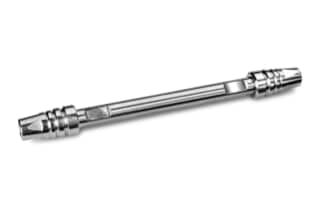
Suggested Use: Peptide Separations, Peptide Analysis
|
Chemistry |
C18 |
|
Separation Mode |
Reversed Phase |
|
Temperature Limits |
90 C |
|
Maximum Pressure |
10000 psi (689 Bar) |
|
Particle Size |
2.5 µm |
|
Pore Size |
130 Å |
|
QC Tested |
Peptide |
|
Format |
Column |
|
System |
HPLC, UHPLC |
|
Particle Technology |
BEH |
|
USP Classification |
L1 |
|
Inner Diameter |
4.6 mm |
|
Length |
150 mm |
|
UNSPSC |
41115709 |
|
Application |
Peptide |
|
Brand |
XBridge |
|
Product Type |
Columns |
|
Units per Package |
1 pk |

XBridge Peptide BEH C18 XP Column, 130Å, 2.5 µm, 4.6 mm X 150 mm, 1/pk
Utilize the XBridge Peptide BEH C18 XP Column to analyze samples for proteomics with the widest usable pH range at low pH stability and ultra-low column bleed. The lab equipment also supports protein characterization and peptide synthesis using the trifunctionally bound BEH particle. Peptide separations are adjusted and quality-controlled evaluated for using the XBridge BEH C18 Peptide Separation Technology (PST) columns.
Benefit from the analytical column's Protein Separation Technology, which integrates BEH technology and uses synthetic particles that deliver the best quality along with consistent performance, by adding the XBridge Peptide BEH C18 XP Column to your collection of lab equipment.
To ensure that peptide separation techniques are stable, the XBridge Peptide BEH C18 XP Column is quality-controlled and evaluated using a peptide map. This is made achievable by employing well-studied, cutting-edge bonding techniques for the C18 ligand, which give predictable behavior with the range of samples utilized in proteomics, protein characterization, and peptide synthesis. You may rely on the analytical column's dependability as a result, and you will receive reliable batch-to-batch separations of synthetic peptides and protein digests. The processes utilized to make the lab equipment guarantee stable particle structure and bonding chemistry across a wide pH range and at high temperatures.
The packing materials for the XBridge Peptide BEH C18 columns are produced in a cGMP, ISO 9002 certified facility using an ultra-pure reagent and have been engineered to give good peak shape, high efficiency, and outstanding stability. Every batch of XBridge Peptide BEH C18 Column material is qualified with a peptide separation, and the outcomes are held to predefined tolerance limits. To ensure great, repeatable performance for peptide separations, this is done. Each column is packaged with a Performance Test Chromatogram and a Certification of Acceptance and undergoes extensive testing before being shipped out.
Protect your analytical column from harm by using the XBridge Peptide BEH C18 VanGuard Cartridge, 130Å, 2.5 µm, 3.9 mm X 5 mm, 3/pk alongside the column. The cartridge is made using the exact same materials that are present in the column, making the two lab equipment ideally suited. The cartridge prevents the entry of unwanted pollutants into the mobile stream, ensuring that the analysis results you receive are more accurate and reliable. The use of the cartridge also makes sure that the column lasts a long time.
Why Is Protein Separation Crucial?
The characterization of the function, structure, and interactions of the target protein depends on its purification. The process of purification may first separate the mixture's protein and non-protein components before separating the desired protein from all other proteins.